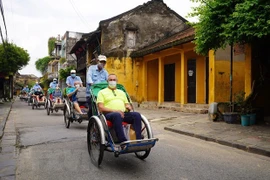 More open policy is needed to attract international tourists to Vietnam during post-pandemic recovery. (Photo: VNA)
More open policy is needed to attract international tourists to Vietnam during post-pandemic recovery. (Photo: VNA)Hanoi (VNA) – Tourism officials and National Assembly deputies share the view that a more open policy is needed to attract international tourists to Vietnam during post-pandemic recovery.
To this end, they proposed scrapping the 10,000 USD COVID-19 travel insurance, expanding the list of visa-free countries and extending visa exemptions to 30 days.
Scrapping COVID insurance
The Ministry of Culture, Sports and Tourism have sent documents to ministries and agencies, seeking their feedback on scrapping the travel insurance requirement for pandemic treatment for foreigners entering Vietnam.
It said the pandemic situation is under control and the cost of treatment is not as high as it used to be, as most patients do not need to be hospitalised for as long, and so it should no longer be necessary for tourists to buy insurance of at least 10,000 USD.
As per the current Law on Tourism, international tourists entering Vietnam still need travel insurance in case of accidents and illness, which does not include COVID-19 treatment.
Vietnam reopened its border for international tourism on March 15.
In April and May, requirements for medical declarations and COVID-19 tests were also removed for international arrivals.
Remove 'bottlenecks'
During the third session of the 15th National Assembly, several deputies also proposed the Government put forward policies in support of tourism recovery and development.
Stating that tourism is one of the driving forces behind economic growth across the country, NA delegate Nguyen Duy Minh from the central city of Da Nang said the Government, ministries and agencies should evaluate the implementation of incentives for businesses and labourers in the tourism industry affected by the pandemic.
He stressed the need to identify obstacles, limitations and reasons to seek solutions, and advocated a more open visa policy and expanding the visa exemption list.
The deputy added that Vietnam needs to further promote tourism abroad, encourage investment, and develop night-time tourism, as well as creative and cultural industries.
NA delegate Tran Thi Van, representing the northern province of Bac Ninh, agreed. Van said that the visa waiver period should be extended from 15 days to 30 days.
She also recommended multiple-entry visas, streamlining travel agencies and tourist procedures, and simplifying e-visa issuance at border gates.
Van said that to properly promote Vietnam’s tourism abroad, a professional communication programme is needed, using digital technology. This will increase the presence of the country’s image, helping international visitors to easily find information on travelling in Vietnam from anywhere.
Nguyen Van Hung, Minister of Culture, Sports and Tourism, said that the tourism sector will submit proposals to the Government to address the issues on visas while also revamping its products and striving toward green tourism under the National Tourism Year 2022.
“Community, marine, and leisure tourism are the strengths Vietnam will focus on this summer,” said Hung.
The whole industry will continue to review and improve its human resources, upgrading and promoting destinations and digitalising tourism to achieve the goal of welcoming five million international arrivals to Vietnam this year.
 The number of foreign tourists visiting Vietnam in the first two quarters of this year increased 6.8 times over the same period of last year. (Photo: VNA)
The number of foreign tourists visiting Vietnam in the first two quarters of this year increased 6.8 times over the same period of last year. (Photo: VNA)The number of foreign tourists visiting Vietnam in the first two quarters of this year increased 6.8 times over the same period of last year, reaching 602,000, according to the General Statistics Office.
In June alone, Vietnam welcomed nearly 237,000 foreign arrivals, up nearly 37% compared to the previous month.
Statistics show that the revenue from accommodation and catering services surged nearly 21% in the first six months of the year, and 80% in June, over the same period last year.
Meanwhile, the travel service revenue in the January–June period swelled by more than 94% over the same period last year, thanks to the strong recovery of tourism activities and especially the boom of domestic tourism in the second quarter.
Localities recording high revenues were located all over the country; Hanoi in the north, Da Nang, Quang Nam and Khanh Hoa in the central region and Can Tho in the south.
The capital served more than 8.6 million in the reviewed period, earning over 25 trillion VND, up three times in both number and revenue against the same period last year.
The tourism sector of Ho Chi Minh City reported that the city welcomed 11 million domestic holiday-makers and 478,000 foreigners in the period, up 43% and 100% year-on-year, respectively./.






























